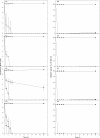Fusarium and Candida albicans biofilms on soft contact lenses: model development, influence of lens type, and susceptibility to lens care solutions
- PMID: 17999966
- PMCID: PMC2223913
- DOI: 10.1128/AAC.00387-07
Fusarium and Candida albicans biofilms on soft contact lenses: model development, influence of lens type, and susceptibility to lens care solutions
Abstract
Fungal keratitis is commonly caused by Fusarium species and less commonly by Candida species. Recent outbreaks of Fusarium keratitis were associated with contact lens wear and with ReNu with MoistureLoc contact lens care solution, and biofilm formation on contact lens/lens cases was proposed to play a role in this outbreak. However, no in vitro model for contact lens-associated fungal biofilm has been developed. In this study, we developed and characterized in vitro models of biofilm formation on various soft contact lenses using three species of Fusarium and Candida albicans. The contact lenses tested were etafilcon A, galyfilcon A, lotrafilcon A, balafilcon A, alphafilcon A, and polymacon. Our results showed that clinical isolates of Fusarium and C. albicans formed biofilms on all types of lenses tested and that the biofilm architecture varied with the lens type. Moreover, differences in hyphal content and architecture were found between the biofilms formed by these fungi. We also found that two recently isolated keratitis-associated fusaria formed robust biofilms, while the reference ATCC 36031 strain (recommended by the International Organization for Standardization guidelines for testing of disinfectants) failed to form biofilm. Furthermore, using the developed in vitro biofilm model, we showed that phylogenetically diverse planktonic fusaria and Candida were susceptible to MoistureLoc and MultiPlus. However, Fusarium biofilms exhibited reduced susceptibility against these solutions in a species- and time-dependent manner. This in vitro model should provide a better understanding of the biology and pathogenesis of lens-related fungal keratitis.
Figures






Similar articles
-
Efficacy of care solutions against contact lens-associated Fusarium biofilms.Optom Vis Sci. 2012 Apr;89(4):382-91. doi: 10.1097/OPX.0b013e31824cb754. Optom Vis Sci. 2012. PMID: 22426175
-
Antifungal efficacy of soft contact lens disinfecting solutions against Fusarium solani and Candida albicans.Clin Exp Optom. 2012 Mar;95(2):207-11. doi: 10.1111/j.1444-0938.2011.00694.x. Epub 2012 Jan 19. Clin Exp Optom. 2012. PMID: 22260336
-
Report on testing from an investigation of fusarium keratitis in contact lens wearers.Eye Contact Lens. 2006 Dec;32(6):256-61. doi: 10.1097/01.icl.0000245556.46738.14. Eye Contact Lens. 2006. PMID: 17099384
-
Fusarium keratitis and contact lens wear: facts and speculations.Med Mycol. 2008 Aug;46(5):397-410. doi: 10.1080/13693780801961352. Epub 2008 Apr 4. Med Mycol. 2008. PMID: 18608899 Review.
-
Contact lens-related Fusarium infection: case series experience in New York City and review of fungal keratitis.Eye Contact Lens. 2007 Nov;33(6 Pt 1):322-8. doi: 10.1097/ICL.0b013e3180645d17. Eye Contact Lens. 2007. PMID: 17993829 Review.
Cited by
-
Antimicrobial Efficacy of Multipurpose Disinfecting Solutions in the Presence of Contact Lenses and Lens Cases.Eye Contact Lens. 2018 Mar;44(2):125-131. doi: 10.1097/ICL.0000000000000308. Eye Contact Lens. 2018. PMID: 27598555 Free PMC article.
-
Management of Black Root Disease-Causing Fungus Fusarium solani CRP1 by Endophytic Bacillus siamensis CNE6 through Its Metabolites and Activation of Plant Defense Genes.Microbiol Spectr. 2023 Feb 6;11(2):e0308222. doi: 10.1128/spectrum.03082-22. Online ahead of print. Microbiol Spectr. 2023. PMID: 36744908 Free PMC article.
-
Widespread occurrence of diverse human pathogenic types of the fungus Fusarium detected in plumbing drains.J Clin Microbiol. 2011 Dec;49(12):4264-72. doi: 10.1128/JCM.05468-11. Epub 2011 Oct 5. J Clin Microbiol. 2011. PMID: 21976755 Free PMC article.
-
Antibacterial and antibiofouling clay nanotube-silicone composite.Med Devices (Auckl). 2018 Apr 16;11:123-137. doi: 10.2147/MDER.S146248. eCollection 2018. Med Devices (Auckl). 2018. PMID: 29713206 Free PMC article.
-
Clonality, recombination, and hybridization in the plumbing-inhabiting human pathogen Fusarium keratoplasticum inferred from multilocus sequence typing.BMC Evol Biol. 2014 Apr 26;14:91. doi: 10.1186/1471-2148-14-91. BMC Evol Biol. 2014. PMID: 24766947 Free PMC article.
References
-
- Adler, D. E., T. H. Milhorat, and J. I. Miller. 1998. Treatment of rhinocerebral mucormycosis with intravenous, interstitial, and cerebrospinal fluid administration of amphotericin B: case report. Neurosurgery 42:644-648. - PubMed
-
- Agarwal, A., A. Gupta, V. Sakhuja, P. Talwar, K. Joshi, and K. S. Chugh. 1991. Retinitis following disseminated cryptococcosis in a renal allograft recipient. Efficacy of oral fluconazole. Acta Ophthalmol. (Copenhagen) 69:402-405. - PubMed
-
- Agrawal, V., J. Biswas, H. N. Madhavan, G. Mangat, M. K. Reddy, J. S. Saini, S. Sharma, and M. Srinivasan. 1994. Current perspectives in infectious keratitis. Ind. J. Ophthalmol. 42:171-192. - PubMed
-
- Ahearn, D. G., R. B. Simmons, S. Zhang, R. D. Stulting, S. A. Crow, B. L. Schwam, and G. E. Pierce. 2007. Attachment to and penetration of conventional and silicone hydrogel contact lenses by Fusarium solani and Ulocladium sp. in vitro. Cornea 26:831-839. - PubMed
-
- Ajayi, B. G., B. Osuntokun, O. Olurin, O. O. Kale, and T. A. Junaid. 1986. Orbital histoplasmosis due to Histoplasma capsulatum var. duboisii: successful treatment with Septrin. J. Trop. Med. Hyg. 89:179-187. - PubMed
Publication types
MeSH terms
Substances
Associated data
- Actions
- Actions
- Actions
- Actions
- Actions
- Actions
- Actions
- Actions
- Actions
Grants and funding
LinkOut - more resources
Full Text Sources
Other Literature Sources
Molecular Biology Databases

